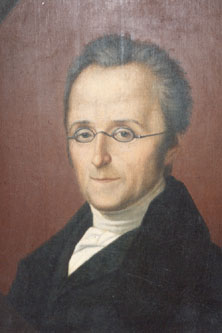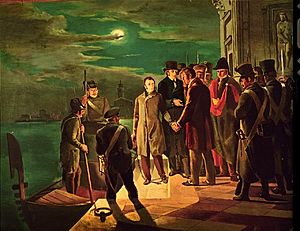Silvio Pellico facts for kids
Silvio Pellico (born June 24, 1789 – died January 31, 1854) was an Italian writer, poet, and playwright. He was also a patriot who worked to help unite Italy. This period is known as the Italian unification, when different parts of Italy became one country.
Contents
Biography
Silvio Pellico was born in Saluzzo, a town in Piedmont, Italy. He spent his early years in Pinerolo and Turin, where he was taught by a priest. When he was just ten years old, he wrote a play! Later, he moved to Lyon, France, for four years to study French literature.
In 1810, he returned to Milan and became a professor of French at a military school. He wrote a play called Francesca da Rimini, which became very popular in Milan in 1818. He also wrote another play, Euphemio da Messina, but it was not allowed to be performed.
Silvio Pellico also worked as a tutor for the sons of important families. He believed in helping Italy become free from the control of the Austrian Empire. He tried to do this through education and writing.
In 1818, he helped start a magazine called Conciliatore. This magazine was a way for people to share ideas about freedom. However, the Austrian officials censored the magazine, meaning they controlled what could be published. The magazine only lasted for about a year before the government shut it down.
In October 1820, Pellico was arrested. He was accused of being part of a secret society called the Carbonari, which worked for Italian freedom. He was taken to the Santa Margherita prison and later to the Piombi prison in Venice. During his time in prison, he continued to write poems and plays.
In February 1822, he was sentenced to a long time in jail. This sentence was later changed to fifteen years. In April, he was moved to the Spielberg prison in Brünn (now Brno). While there, he wrote another play called Leoniero da Dertona, which he had to remember by heart.
Silvio Pellico was finally released from prison in 1830. After his release, he started publishing the works he had written while imprisoned. In 1832, he published his most famous book, Le mie prigioni (which means "My Prisons"). This book told the story of his difficult time in jail.
My Prisons became very famous across Europe. It helped people understand the struggles for freedom in Italy. The book was translated into almost every European language during his lifetime. It also helped inspire people to support the Italian unification against Austrian rule.
After his parents passed away in 1838, he lived with the Marchesa Juliette Colbert de Barolo, who was known for her charity work. He helped her with her good deeds and mostly wrote about religious topics. He died in Turin in 1854.
Main works
- Francesca da Rimini (1818) – A successful play.
- Le mie prigioni (My Prisons) (1832) – His most famous book, describing his time in prison.
Images for kids
See also
 In Spanish: Silvio Pellico para niños
In Spanish: Silvio Pellico para niños




